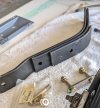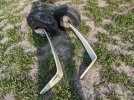When somebody asks me about taildraggers? Cub, Skywagon. The kings of taildragging. If your budget doesn’t fit those? PA-20.
And if PA-20, maybe a PA22/20 with the slightly wider main gear after conversion to taildragger.
When somebody asks me about taildraggers? Cub, Skywagon. The kings of taildragging. If your budget doesn’t fit those? PA-20.
Hi, great questionsWhat's your budget? What's your in plan? Do you want something you can teach in once you are insurable? Do you want something you can still in 12 months? Do you want something you can keep and play around with?
The reason I suggested a Stearman (which is probably not going to fit your budget, sadly) is because, to a greater extent than any other plane within reach of mortals, it has a reputation for making you a better tailwheel pilot. For someone whose goals don't include becoming a great tailwheel instructor, I would have recommended a recent production run Champ. They're comfortable, cheap to keep, and only limited by useful load which isn't a problem flying solo. The problem is that they're too easy to land, so they won't do much to prepare you to save a student's botched landing when you're in the front seat of a J-3 or the back seat of a T-6.My plan is to fly single pilot to build tailwheel hours and experience.
I got mine in a citabria in about 10 hours...it made the later flights in Taylorcrafts and Cubs ridiculously easy.A Citabria is great for learning and teaching in. Not too difficult but not too easy. Plenty of them available, still being made, and good support.
Based on your size and the above critera I think a stock 7AC Champ is the clear winner for what you want with the Roomy cockpit and low cost.Hi, great questions
I'd like to buy something as budget friendly as possible. 40K seems like a good budget for now.
My plan is to fly single pilot to build tailwheel hours and experience.
I DO NOT want to teach in it.
I don't know that I would own this long term. I could see owning for a year or two and then being able to sell
As a Luscombe owner, I think he'd be very challenged to get checked out first... so I'd advise against that.If the intent is to become a good tailwheel pilot at reasonable cost, a Luscombe makes sense. I learned how to fly in one, and particularly if you’ve never flown any other taildragger learning what your feet are for is very doable. An Aeronca or Citabria is surely bigger inside but if you’re flying solo in the Luscombe it might work and you’ll learn a bit more.
As mentioned by others if you’re planning on flying with a passenger in most training taildraggers it’d be beneficial to be thinner.
The tanks aren’t huge to begin with, and many aircraft are heavier than the numbers I posted. My aircraft is a very light example with minimal instruments and interior. I asked for weight and balance on all the planes I looked at and it wouldn’t be uncommon to see planes 10-40 lbs heavier.No one said you have to fill the tanks. Especially on a local checkout flight.
Useful load for two person Luscombe checkout is a good point that I hadn’t considered. Mine had 445 lb useful load, subtracting 14 gallons for fuel would leave you 361 lbs for crew.
This issue would also apply to any plane with a similar useful load. It seems to me that with a 250 lb pilot, you’d need perhaps 540 lb useful load to account for another pilot plus fuel for short training flights. Certainly over 500 lbs.
This is true. In some variants, max gross is limited by gear flex, not by flight performance. Most notable example is the Super Decathlon. An older 8KCAB loaded 200# over gross will take off in 800 feet, climb at 800fpm, and has no appreciable difference in stall/spin characteristics. But because it has the same gear legs as the Citabria, a poorly executed wheel landing at/over max gross stands a fair chance of causing a prop strike. That is why adding the new (2005) gear legs to a metal spar aircraft allows an MGW increase of 150 pounds in normal category.Any more if you see a Champ, Cub, Citabria, Luscombe or similar taxing out with two people in it, there is probably a better than 50% chance that the plane is over gross weight.
With usually no more than a 13gal tank (standard tanks, Citabria is a bit better with larger tanks) and any aux tanks dry, even going 1/2 tank only gives you about 40lbs more useful load and they are taking off with only 6.5 gallons of gas, which usually means on the ground the tank fuel gauge is reading 1/4 to 1/3 full.
Brian
This is true. In some variants, max gross is limited by gear flex, not by flight performance. Most notable example is the Super Decathlon. An older 8KCAB loaded 200# over gross will take off in 800 feet, climb at 800fpm, and has no appreciable difference in stall/spin characteristics. But because it has the same gear legs as the Citabria, a poorly executed wheel landing at/over max gross stands a fair chance of causing a prop strike. That is why adding the new (2005) gear legs to a metal spar aircraft allows an MGW increase of 150 pounds in normal category.
The price is so cheap relative to most airplane parts, I figured the Decathlon springs were repurposed automotive leaf springs or something. Maybe they are just easy to make?I don't know about the rest of the landing gear, but I do know the Scout uses a heavier tailwheel spring than the Citabria, which uses a heavier spring than the Champ. (I know this from researching a replacement spring for my Hatz, for which the originally specified Champ spring was too light but the Citabria spring is just right.)


